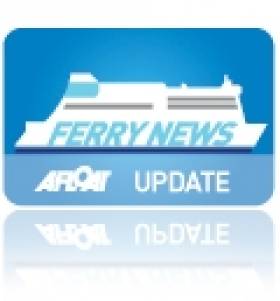Displaying items by tag: Freightferries
Seatruck’s New Freight-Ferry to Make December Debut
Seatruck, which claims 20% of the Irish Sea market compared to just 3.7% in 2004, says it will transport 300,000 units in 2011 on its four routes: Dublin-Liverpool, Dublin-Heysham, Warrenpoint-Heysham and Larne-Larne. With the introduction of the newer larger vessels, Seatruck is aiming at the 45% of Irish Sea freight market that is still driver-accompanied.
Alistair Eagles, MD of Seatruck (Irish Sea) says that his company's share of unaccompanied freight volumes is set to grow in 2012, although the total Irish Sea ro-ro market is set to remain static next year, but better than a 1% decline in 2011.
Mr Eagles said: "We believe that our sector of the market — freight-only unaccompanied — will continue to grow. By offering pure freight services we can keep the costs down relatively lower compared with the combined passenger and freight ferry operators.
"We are seeing a switch away from driver-accompanied shipments because hauliers can save quite a lot of money."
Seatruck also benefited from a radical shake-up on the Irish Sea ferry market, with largescale withdrawals of capacity by DFDS and other changes, notably taking over the Dublin-Heysham route in February, to read more click HERE. The route is served by the chartered 120-unit Anglia Seaways which has accommodation for 12 drivers.
As for the remaining newbuild pair, they are scheduled for delivery from FGS during the first half of 2012 and deployed on yet-to-be announced routes. Like the new quartet, the same number were ordered of the 'P' class which entered service from 2008 onwards which included Clipper Pace and Clipper Panorama which currently operate 22 weekly sailings on the Warrenpoint-Heysham route.
Seatruck also operate Clipper Ranger and Arrow on Larne-Heysham sailings, where they each provide a capacity of 65 units and offer driver accompanied traffic with accommodation in en-suite cabins.
Prior to her arrival on the North Channel, Norcape had been laid-up in Liverpool since February 2010 after the former B+I Line vessel (MV Tipperary) was replaced by European Endeavour on the central corridor route to Dublin. As of this week the ro-pax freight vessel which has been running in a freight-only mode will now carry motorists likewise to her route fleetmates Norbank and Norbay.
With the departure of European Mariner from the Irish Sea, she follows a trio of former Stena Line freight-ferry sisters which were made redundant since the closure of the Belfast-Heysham route late last year. It is believed the sisters Stena Seafarer, Stena Leader and Stena Pioneer have been sold to Russian interests to serve in the Black Sea in connection to the 2014 Winter Olympics in Sochi.
The sisters were renamed, Stena Pioneer became Ant 1, Stena Seafarer is the Ant 2 and Stena Leader is the Anna Marine. They departed Belfast Lough in mid-June to Sevastopol in the Ukraine under the Moldovan flag and with a port of registry in Giurgiulesti.
- Port of Larne
- Belfast Lough
- Stena Line
- Ports and Shipping News
- RoPax
- North Channel
- P&O (Irish Sea)
- B+I Line
- European Endeavour
- Ferry news
- Belfast Lough News
- RosslareFishguard
- LarneTroon
- European Mariner
- Freightferries
- MV Tipperary
- Central Coridoor route
- BelfastFleetwood
- Stena Europe ferry
- 2014 Winter Olympics
- Sochi
- Black Sea
- Turkish shipbreakers
- Izmir
- Turkey
- Winter Olympics 2014
- Irish Sea ferry motorists






























































